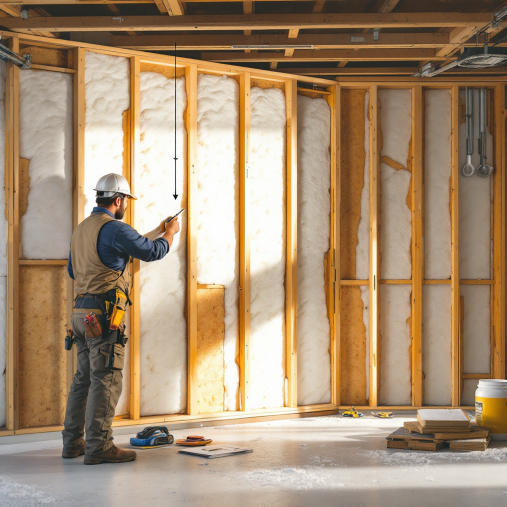Insulating your garage walls is more than just a home improvement project—it’s a wise investment that can enhance energy efficiency, improve comfort, and boost your property value. Whether you want to turn your garage into a functional space or reduce heat loss, properly insulating the house garage wall is essential.
Why Garage Wall Insulation Matters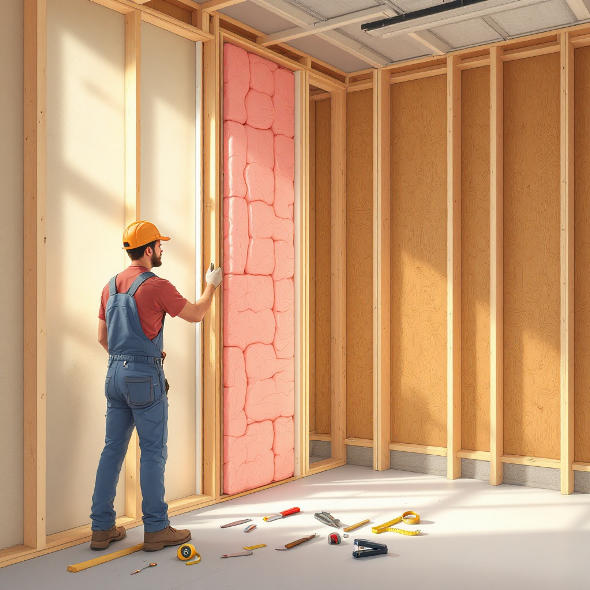
Benefits of Insulating Garage Walls
Insulating your garage walls isn’t just about keeping things warm. Here are some of the most significant benefits:
- Energy Efficiency: Uninsulated garages can act as energy sinks, making your home’s heating and cooling systems work harder. Insulation reduces heat transfer and saves on your energy bills.
- Enhanced Comfort: Insulation helps maintain a consistent temperature in garages attached to your house, making the space more livable and less drafty.
- Moisture Control: Proper insulation prevents condensation, reducing the risks of mold and mildew.
- Increased Property Value: A well-insulated garage adds to your property’s overall appeal and value for potential buyers.
By the end of this article, you’ll have all the tools and knowledge to insulate your garage walls like a pro!
Understanding Garage Wall Insulation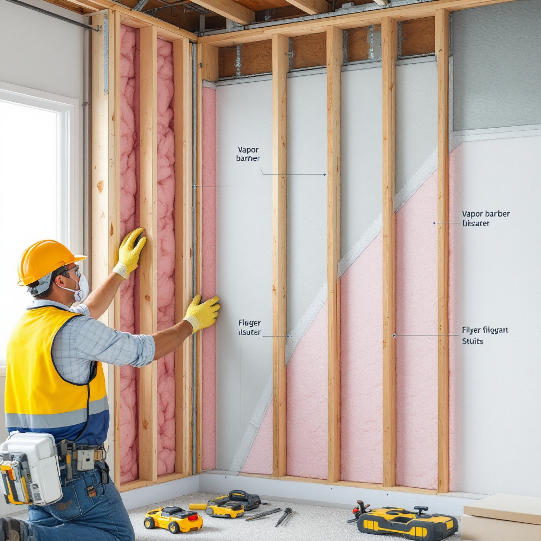
What Is Garage Wall Insulation?
Garage wall insulation uses specific materials to reduce heat transfer through the walls of your garage. Unlike other parts of the home, garage walls often lack insulation, leading to temperature extremes. Proper insulation acts as a barrier, keeping warm air in during winter and hot air out during summer.
You may also read(after being away my house).
Why Insulate Your Garage Walls?
Garage walls are often overlooked when it comes to insulation. However, here are a few reasons why you should prioritize insulating your garage:
- Energy Savings: Insulating garage walls can reduce the energy needed to heat or cool your home, especially if the garage is attached.
- Convert the Garage: If you’re turning your garage into a workshop, gym, or living space, insulation is necessary for comfort.
- Protect Against the Elements: Insulation blocks moisture, prevents mold, and keeps pests at bay.
- Soundproofing: Insulation can help reduce noise transfer, particularly if the garage is used as a workspace.
Types of Garage Walls and Their Impact on Insulation
Single-Skin vs. Double-Skin Walls
The type of walls your garage has will determine the insulation options available:
- Single-Skin Walls: These are simpler, thinner walls, often made of concrete or brick. They have no cavity, so insulation needs to be applied externally or internally.
- Double-Skin Walls: These walls have a cavity between two layers, allowing cavity wall insulation to be installed.
How to Identify Your Wall Type: Check for a visible cavity or consult your garage construction plans.
Attached vs. Detached Garages
The location of your garage also plays a significant role:
- Attached Garages: These share walls with the house, so insulation is critical to prevent heat transfer between the spaces.
- Detached Garages: Insulating detached garages can still make them more functional and energy-efficient while not connected to the home.
Choosing the Right Insulation Material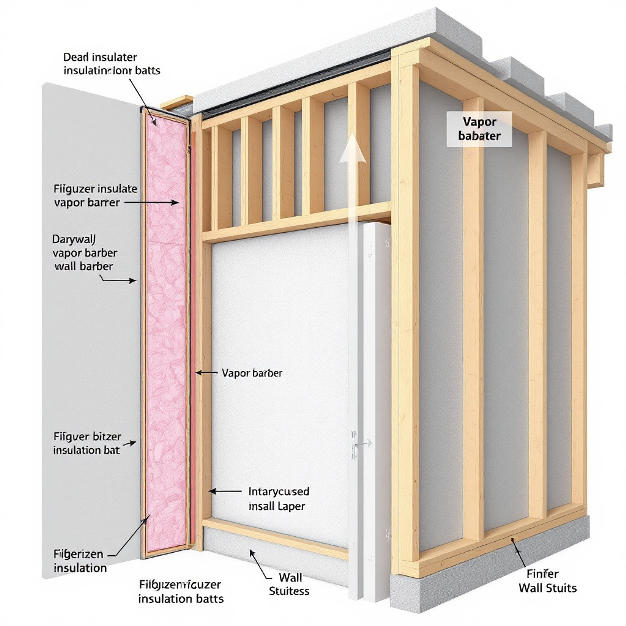
When considering how to insulate a house garage wall, choosing the right material is key. Let’s explore some common types of insulation:
Overview of Popular Insulation Types
- Fiberglass Batts
- R-Value Range: R-13 to R-21
- Pros: Affordable, readily available, and DIY-friendly.
- Cons: Can trap moisture if not properly sealed.
- Rigid Foam Boards
- R-Value Range: R-5 to R-6 per inch
- Pros: Moisture-resistant, thin, and durable.
- Cons: Higher upfront cost and requires precise cutting.
- Spray Foam
- R-Value Range: R-6 to R-7 per inch
- Pros: Superior air sealing and high R-value.
- Cons: Expensive and requires professional installation.
- Mineral Wool
- R-Value Range: R-15 to R-23
- Pros: Fire-resistant and excellent soundproofing.
- Cons: Heavier and pricier than fiberglass.
Comparison Table: Insulation Types for Garage Walls
Insulation TypeR-ValueAdvantagesDisadvantages
Fiberglass Batts R-13 to R-21 Affordable, easy to install Moisture retention risk
Rigid foam board R-5 to R-6 is thick, moisture-resistant, and expensive; cutting is required.
Spray Foam R-6 to R-7 High R-value, air-sealing High cost, pro install needed
Mineral Wool R-15 to R-23 Fire-resistant, soundproof Heavy, higher price
Preparation: How to Get Your Garage Wall Ready
Before you start insulating, the preparation phase is critical.
Clearing and Assessing the Space
- Remove Obstructions: Take down shelving, tools, and wall coverings like drywall or paneling.
- Inspect Stud Cavities: Make sure there’s no mold, chemicals, or debris in the wall cavities.
Inspecting for Damage
- Cracks and Gaps: Look for cracks, gaps, and holes in the wall structure.
- Water Damage: Fix any signs of water intrusion to prevent mold growth.
Sealing Air Leaks
- Use Caulk or Expanding Foam: Seal gaps around windows, doors, and wall penetrations.
- Focus on Problem Areas: Pay attention to the edges where the garage wall meets the floor or ceiling.
Step-by-Step Guide: How to Insulate House Garage Wall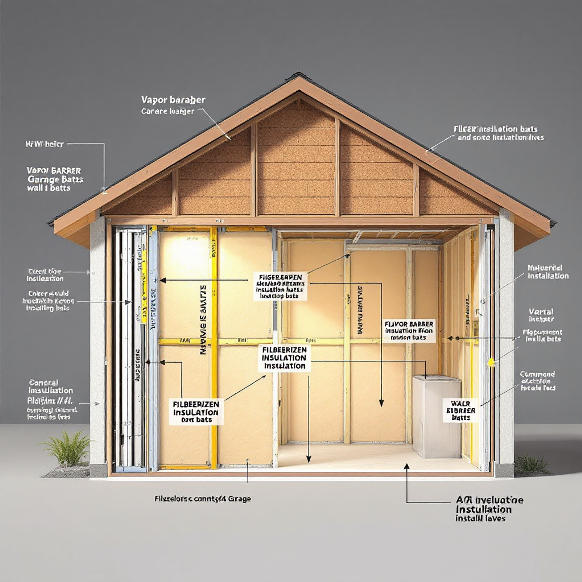
Now that your garage is prepped, it’s time to install insulation.
Remove Wall Coverings
- Tools: Hammer, utility knife, and screwdriver.
- Safely remove drywall or paneling to access the wall studs.
Seal Gaps and Cracks
- Apply expanding foam or caulk to all visible cracks and gaps.
- Let the sealant dry before moving to the next step.
Install Insulation
- Measure and Cut: Cut the insulation to snugly between the wall studs.
- Fit Without Compression: Ensure the insulation isn’t compressed, as this reduces its effectiveness.
Apply a Vapor Barrier
- In humid climates, add a vapor barrier to prevent moisture buildup.
- Secure it tightly with staples or adhesive.
Reinstall Wall Coverings
- Replace drywall or paneling.
- Smooth out and finish the walls with paint or wallpaper if needed.
Optional Insulation Areas
- Insulate the garage ceiling for added efficiency.
- Consider insulating the garage door and floor as well.
Special Considerations
Moisture Management
- Install a vapor barrier to avoid condensation.
- Proper ventilation is crucial to prevent mold.
Electrical and Plumbing Obstructions
- Use insulation split around pipes and wires to avoid damaging them.
Fire Safety
- Keep insulation away from heat sources and light fixtures.
Common Mistakes to Avoid
- Ignoring air leaks before installing insulation.
- Using insulation with insufficient R-value for your climate.
- Overlooking the garage door is a significant source of heat loss.
- Neglecting proper ventilation.
DIY vs. Professional Installation
When to DIY
- If your garage has simple wall structures.
- You’re using easy-to-handle materials like fiberglass batts.
When to Hire a Professional
- For spray foam insulation or complex garage layouts.
- Ensuring compliance with building codes.
You may also read (house garage door water)

